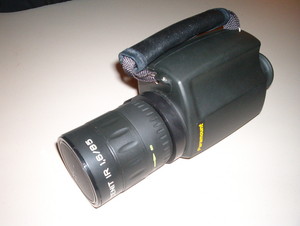Do you ever wonder what lurks outside your doors at night? What wanders in the far reaches of your yard? What eyes peer out at you from the nearby woods? What does your dog see and why is he barking? I’ve often wondered about these things and wished that I could see into the darkness and know what is out there. But, the expense of night vision gear has always kept me in the dark. Recently, a friend loaned me a Paramount Moonlight Night Vision 3.6x Monocular so that I could try it out for a few months. It was my first opportunity to play with night vision equipment for an extended period of time. I could walk into the darkness with new eyes like a superhero.
As a night vision device, this monocular is a fairly crude first generation Russian device. The unit is identical cosmetically to the Russian Zenit NV-100K Night Vision Scope and sports a Zenit labeled objective marked IR 1,6/85. The scope is equipped with a small detachable infrared illuminator. From an ergonomic perspective, the unit is bulky but fairly easy to use. You simply slip your hand into the back-strap that runs along the side of the scope. Your thumb will be naturally positioned to press the button triggering the IR illuminator. You can focus by adjusting the objective and the eyepiece. At times, this can be difficult. It is very easy to inadvertently remove the objective by twisting it out the scope body (like a camera lens) instead of adjusting the focus ring. You have to be very careful not to accidentally drop the objective when this happens. The scope body itself is constructed of fairly heavy duty plastic that does flex a little along the seams. The unit is powered by two AA batteries which fit into a compartment beneath the hand strap. Replacing batteries requires that a single screw be removed so that the battery compartment can be opened. The unit weighs a little over 2 pounds. Overall, the construction is fairly substantial but the unit should still be handled with care.
The measure of any night vision monocular is how well it allows users to see in the dark. I found that the Paramount Moonlight Monocular (or perhaps Zenit NV-100) worked well at brightening dark areas. When activated, the IR illuminator completely brightened an area like a strong flashlight. However, it was sometimes difficult to interpret what I was seeing through the eyepiece. The in focus field of view was quite narrow. It seemed narrower than most telescope or binocular views. You also have to use caution not to aim the unit at street lights or other bright lights that might damage the image intensifier. In a heavily developed suburban area, I found that when I was panning across a landscape, I would have to repeatedly aim the monocular away from streetlights. Whenever it got within a few degrees of a bright light, the view in the eyepiece would start to get fuzzy. In addition, the unit seemed to be sensitive to being focused on a specific distance. When looking into woods, I found my vision unclear and thrown off when branches were out of focus in the foreground or when I changed to a target that was further away than my original point of focus. The Paramount Moonlight Night Vision Monocular was easier to use when looking across open fields. However, once you get accustomed to focusing and using the unit, you can actually see objects fairly easily. Objects are clear when they are in focus and centered in the field of view. When the IR illuminator is used, the landscape brightens considerably. While I am being somewhat critical for the purposes of providing a comprehensive review, for the first time, the Moonlight Night Vision Monocular was allowing me to see at night and it was exciting.
I used the superpowers provided by the night vision monocular to easily navigate my way across a couple of holes on a local golf course and to scan each water hazard for signs of life. I also scanned greens for deer and other wildlife. I also walked about 100 yards down a dark wooded path and could see and navigate very well. But, even with night vision, the experience was thoroughly creepy. It was fun to use the night vision monocular to seek the creatures that my dog was looking for in the woods. However, 9 times out of 10, the dog picked up on rabbits and cats long before I did. I was disappointed not to see more wildlife with the Paramount Moonlight Night Vision monocular. However, if you live in an urban area, there are not many animals to see. Only once did I see a rabbit before my dog scared him off. The Paramount Night Vision Monocular simply does not provide super sensitive hearing capabilities or make your nose a million times more sensitive. As a novelty, I could definitely see the fun and overall usefulness of owning a night vision monocular. Companies like Bushnell, Night Owl Optics. and Yukon Advanced Optics are now offering low magnification night vision monoculars for less than $200. While many of these units still use Generation 1 night vision technology, they offer much lighter weight, smaller size, and integrated IR illuminators. However, the Paramount Moonlight Night Vision Scope and the comparable Zenit NV-100K Night Vision Scope are sometimes available on Internet auction sites at low prices. However, if this night vision monocular allows you to see Bigfoot before Bigfoot sees you, any price might be worth paying.





